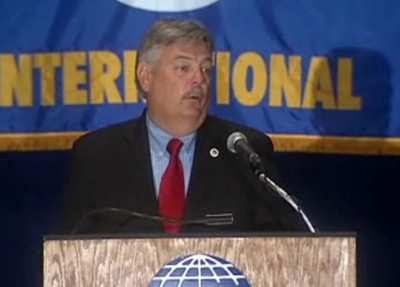Prater Tells Committee Pilot Fatigue Represents A "Dire"
Threat
 In testimony before a U.S. Senate subcommittee on Tuesday,
Capt. John Prater, president of the Air Line Pilots Association,
Int’l, (ALPA), told senators that current federal flight- and
duty-time rules for airline pilots are obsolete and modern
science-based regulations are needed now to combat pilot fatigue
and safeguard passengers and cargo.
In testimony before a U.S. Senate subcommittee on Tuesday,
Capt. John Prater, president of the Air Line Pilots Association,
Int’l, (ALPA), told senators that current federal flight- and
duty-time rules for airline pilots are obsolete and modern
science-based regulations are needed now to combat pilot fatigue
and safeguard passengers and cargo.
“We are disappointed by the FAA’s announcement that
the draft regulation will be delayed until early next year, but we
expect work to remain on track to create a new regulation by
mid-2010,” said Prater after his testimony before the
Aviation Operations, Safety, and Security Subcommittee of the U.S.
Senate Committee on Commerce, Science, and Transportation.
“The threat from pilot fatigue is dire, and the decisive
action our industry needs from the FAA can’t come quickly
enough.”
The existing rules date from the 1950s and are “a
stick-and-wire biplane struggling to stay aloft in a supersonic
age,” Prater said in his testimony to the members of the
Senate. “I ask for your help in giving the flying public a
new, consistent level of safety by ensuring that every pilot in the
United States starts every trip alert and rested.”
Prater said the new rule on pilot fatigue must meet three
criteria to be truly effective: it must be based on scientific
research into human fatigue and circadian rhythms, it should be
uniform for all airline pilots, and it should encourage airline
managers and pilot unions to collaborate in setting up voluntary
Fatigue Risk Management Systems (FRMS) at their individual
carriers.

John Prater
“No science exists to support multiple sets of flight-time
and duty-time limits. No rational argument can be made for
different flight/duty rules for pilots based on whether they fly
passengers or cargo, domestic or international,” he said.
Prater pointed to existing rules that allow cargo pilots to fly up
to 60 percent more hours in a given week than pilots carrying
passengers within the United States. “Exceptions or
‘carve-outs’ would kill long-overdue efforts to ensure
all pilots are well rested. Worse, carve-outs would undermine the
one-level-of-safety principle that must remain our ultimate
goal.”
Seven ALPA pilots representing every spectrum of the airline
industry participated in an Aviation Rulemaking Committee (ARC)
that made recommendations to the FAA. FAA Administrator Randy
Babbitt had publicly stated that his agency would publish a notice
of proposed rulemaking (NPRM) on this vital aviation safety issue
by the end of 2009, and issue a final rule next year.
“I remain encouraged that we finally appear to be on the
verge of securing the modern, science-based flight- and duty-time
rules we know are so vital to enhancing aviation safety,”
concluded Prater. “We look forward to evaluating the
FAA’s proposed rule, and challenge the administration to stay
on target for a final rule by mid-2010.”
 ANN's Daily Aero-Linx (05.02.24)
ANN's Daily Aero-Linx (05.02.24) ANN's Daily Aero-Term (05.02.24): Touchdown Zone Lighting
ANN's Daily Aero-Term (05.02.24): Touchdown Zone Lighting Aero-News: Quote of the Day (05.02.24)
Aero-News: Quote of the Day (05.02.24) ANN FAQ: Contributing To Aero-TV
ANN FAQ: Contributing To Aero-TV NTSB Final Report: Cirrus Design Corp SR20
NTSB Final Report: Cirrus Design Corp SR20




